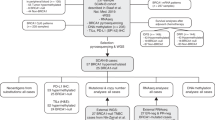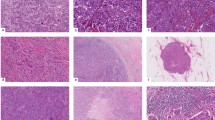Abstract
Basal-like breast cancers form a distinct subtype of breast cancer characterized by the expression of markers expressed in normal basal/myoepithelial cells. Breast cancers arising in carriers of germline BRCA1 mutations are predominately of basal-like type, suggesting that BRCA1 dysfunction may play a role in the pathogenesis of sporadic basal-like cancers. We analysed 37 sporadic breast cancers expressing the basal marker cytokeratin 5/6, and age- and grade-matched controls, for downregulation of BRCA1. Although BRCA1 promoter methylation was no more common in basal-like cancers (basal 14% vs controls 11%, P=0.72), BRCA1 messenger RNA expression was twofold lower in basal-like breast cancers compared to matched controls (P=0.008). ID4, a negative regulator of BRCA1, was expressed at 9.1-fold higher levels in basal-like breast cancer (P<0.0001), suggesting a potential mechanism of BRCA1 downregulation. BRCA1 downregulation correlated with the presence of multiple basal markers, revealing heterogeneity in the basal-like phenotype. Finally, we found that 63% of metaplastic breast cancers, a rare type of basal-like cancers, had BRCA1 methylation, in comparison to 12% of controls (P<0.0001). The high prevalence of BRCA1 dysfunction identified in this study could be exploited in the development of novel approaches to targeted treatment of basal-like breast cancer.
This is a preview of subscription content, access via your institution
Access options
Subscribe to this journal
Receive 50 print issues and online access
$259.00 per year
only $5.18 per issue
Buy this article
- Purchase on Springer Link
- Instant access to full article PDF
Prices may be subject to local taxes which are calculated during checkout


Similar content being viewed by others
References
Abd El-Rehim DM, Ball G, Pinder SE, Rakha E, Paish C, Robertson JF et al. (2005). High-throughput protein expression analysis using tissue microarray technology of a large well-characterised series identifies biologically distinct classes of breast cancer confirming recent cDNA expression analyses. Int J Cancer 116: 340–350.
Beger C, Pierce LN, Kruger M, Marcusson EG, Robbins JM, Welcsh P et al. (2001). Identification of Id4 as a regulator of BRCA1 expression by using a ribozyme-library-based inverse genomics approach. Proc Natl Acad Sci USA 98: 130–135.
Brody LC . (2005). Treating cancer by targeting a weakness. N Engl J Med 353: 949–950.
Catteau A, Harris WH, Xu CF, Solomon E . (1999). Methylation of the BRCA1 promoter region in sporadic breast and ovarian cancer: correlation with disease characteristics. Oncogene 18: 1957–1965.
Crook T, Brooks LA, Crossland S, Osin P, Barker KT, Waller J et al. (1998). p53 mutation with frequent novel condons but not a mutator phenotype in BRCA1- and BRCA2-associated breast tumours. Oncogene 17: 1681–1689.
Esteller M, Silva JM, Dominguez G, Bonilla F, Matias-Guiu X, Lerma E et al. (2000). Promoter hypermethylation and BRCA1 inactivation in sporadic breast and ovarian tumors. J Natl Cancer Inst 92: 564–569.
Fabbro M, Rodriguez JA, Baer R, Henderson BR . (2002). BARD1 induces BRCA1 intranuclear foci formation by increasing RING-dependent BRCA1 nuclear import and inhibiting BRCA1 nuclear export. J Biol Chem 277: 21315–21324.
Farmer H, McCabe N, Lord CJ, Tutt AN, Johnson DA, Richardson TB et al. (2005). Targeting the DNA repair defect in BRCA mutant cells as a therapeutic strategy. Nature 434: 917–921.
Foulkes WD . (2004). BRCA1 functions as a breast stem cell regulator. J Med Genet 41: 1–5.
Foulkes WD, Stefansson IM, Chappuis PO, Begin LR, Goffin JR, Wong N et al. (2003). Germline BRCA1 mutations and a basal epithelial phenotype in breast cancer. J Natl Cancer Inst 95: 1482–1485.
Furuta S, Jiang X, Gu B, Cheng E, Chen PL, Lee WH . (2005). Depletion of BRCA1 impairs differentiation but enhances proliferation of mammary epithelial cells. Proc Natl Acad Sci USA 102: 9176–9181.
Ganesan S, Silver DP, Greenberg RA, Avni D, Drapkin R, Miron A et al. (2002). BRCA1 supports XIST RNA concentration on the inactive X chromosome. Cell 111: 393–405.
Gillett CE, Springall RJ, Barnes DM, Hanby AM . (2000). Multiple tissue core arrays in histopathology research: a validation study. J Pathol 192: 549–553.
Herman JG, Graff JR, Myohanen S, Nelkin BD, Baylin SB . (1996). Methylation-specific PCR: a novel PCR assay for methylation status of CpG islands. Proc Natl Acad Sci USA 93: 9821–9826.
Huvos AG, Lucas Jr JC, Foote Jr FW . (1973). Metaplastic breast carcinoma. Rare form of mammary cancer. NY State J Med 73: 1078–1082.
Joukov V, Chen J, Fox EA, Green JB, Livingston DM . (2001). Functional communication between endogenous BRCA1 and its partner, BARD1, during Xenopus laevis development. Proc Natl Acad Sci USA 98: 12078–12083.
Lakhani SR, Reis-Filho JS, Fulford L, Penault-Llorca F, van der Vijver M, Parry S et al. (2005). Prediction of BRCA1 status in patients with breast cancer using estrogen receptor and basal phenotype. Clin Cancer Res 11: 5175–5180.
Lambie H, Miremadi A, Pinder SE, Bell JA, Wencyk P, Paish EC et al. (2003). Prognostic significance of BRCA1 expression in sporadic breast carcinomas. J Pathol 200: 207–213.
Livasy CA, Karaca G, Nanda R, Tretiakova MS, Olopade OI, Moore DT et al. (2006). Phenotypic evaluation of the basal-like subtype of invasive breast carcinoma. Mod Pathol 19: 264–271.
Magdinier F, Ribieras S, Lenoir GM, Frappart L, Dante R . (1998). Down-regulation of BRCA1 in human sporadic breast cancer; analysis of DNA methylation patterns of the putative promoter region. Oncogene 17: 3169–3176.
Matros E, Wang ZC, Lodeiro G, Miron A, Iglehart JD, Richardson AL . (2005). BRCA1 promoter methylation in sporadic breast tumors: relationship to gene expression profiles. Breast Cancer Res Treat 91: 179–186.
Nielsen TO, Hsu FD, Jensen K, Cheang M, Karaca G, Hu Z et al. (2004). Immunohistochemical and clinical characterization of the basal-like subtype of invasive breast carcinoma. Clin Cancer Res 10: 5367–5374.
Perez-Valles A, Martorell-Cebollada M, Nogueira-Vazquez E, Garcia-Garcia JA, Fuster-Diana E . (2001). The usefulness of antibodies to the BRCA1 protein in detecting the mutated BRCA1 gene. An immunohistochemical study. J Clin Pathol 54: 476–480.
Perk J, Iavarone A, Benezra R . (2005). Id family of helix–loop–helix proteins in cancer. Nat Rev Cancer 5: 603–614.
Perou CM, Sorlie T, Eisen MB, van de Rijn M, Jeffrey SS, Rees CA et al. (2000). Molecular portraits of human breast tumours. Nature 406: 747–752.
Reis-Filho JS, Milanezi F, Steele D, Savage K, Simpson PT, Nesland JM et al. (2006). Metaplastic breast carcinomas are basal-like tumours. Histopathology 49: 10–21.
Ribeiro-Silva A, Ramalho LN, Garcia SB, Brandao DF, Chahud F, Zucoloto S . (2005). p63 correlates with both BRCA1 and cytokeratin 5 in invasive breast carcinomas: further evidence for the pathogenesis of the basal phenotype of breast cancer. Histopathology 47: 458–466.
Richardson AL, Wang ZC, De Nicolo A, Lu X, Brown M, Miron A et al. (2006). X chromosomal abnormalities in basal-like human breast cancer. Cancer Cell 9: 121–132.
Ruffner H, Verma IM . (1997). BRCA1 is a cell cycle-regulated nuclear phosphoprotein. Proc Natl Acad Sci USA 94: 7138–7143.
Simpson PT, Gale T, Reis-Filho JS, Jones C, Parry S, Steele D et al. (2004). Distribution and significance of 14-3-3sigma, a novel myoepithelial marker, in normal, benign and malignant breast tissue. J Pathol 202: 274–285.
Sirchia SM, Ramoscelli L, Grati FR, Barbera F, Coradini D, Rossella F et al. (2005). Loss of the inactive X chromosome and replication of the active X in BRCA1-defective and wild-type breast cancer cells. Cancer Res 65: 2139–2146.
Sorlie T, Tibshirani R, Parker J, Hastie T, Marron JS, Nobel A et al. (2003). Repeated observation of breast tumor subtypes in independent gene expression data sets. Proc Natl Acad Sci USA 100: 8418–8423.
Staff S, Isola J, Tanner M . (2003). Haplo-insufficiency of BRCA1 in sporadic breast cancer. Cancer Res 63: 4978–4983.
Turner N, Tutt A, Ashworth A . (2004). Hallmarks of ‘BRCAness’ in sporadic cancers. Nat Rev Cancer 4: 814–819.
Umetani N, Mori T, Koyanagi K, Shinozaki M, Kim J, Giuliano AE et al. (2005). Aberrant hypermethylation of ID4 gene promoter region increases risk of lymph node metastasis in T1 breast cancer. Oncogene 24: 4721–4727.
Acknowledgements
We thank Corrado D'Arrigo for useful discussions, and Louise Jones and Kellie Mulligan of St Bartholomew's Hospital, UK for Ck14 data from the Guy's Hospital Tissue Microarray.
Author information
Authors and Affiliations
Corresponding author
Additional information
Supplementary Information accompanies the paper on the Oncogene website (http://www.nature.com/onc).
Supplementary information
Rights and permissions
About this article
Cite this article
Turner, N., Reis-Filho, J., Russell, A. et al. BRCA1 dysfunction in sporadic basal-like breast cancer. Oncogene 26, 2126–2132 (2007). https://doi.org/10.1038/sj.onc.1210014
Received:
Revised:
Accepted:
Published:
Issue Date:
DOI: https://doi.org/10.1038/sj.onc.1210014
Keywords
This article is cited by
-
Unveiling the vulnerabilities of synthetic lethality in triple-negative breast cancer
Clinical and Translational Oncology (2023)
-
Problematic breast tumors reassessed in light of novel molecular data
Modern Pathology (2021)
-
Synergistic targeting of BRCA1 mutated breast cancers with PARP and CDK2 inhibition
npj Breast Cancer (2021)
-
Estrogen promotes estrogen receptor negative BRCA1-deficient tumor initiation and progression
Breast Cancer Research (2018)
-
PARP Inhibitors in the Treatment of Triple-Negative Breast Cancer
Clinical Pharmacokinetics (2018)



